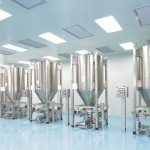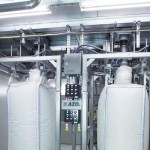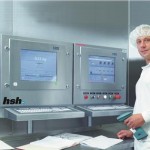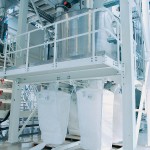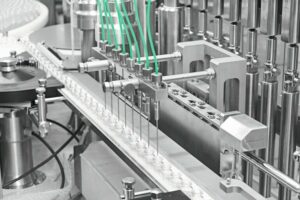In the plant concept presented below, all the raw materials required for the recipe are weighed directly and automatically into big bags and then added to the mixing process. Manufacturers of pharmaceuticals and dietary supplements are thus able to respond very quickly and flexibly to market trends. In addition to production reliability, the main focus is on batch traceability. This is guaranteed by continuous production control.
Walter Sonntag
Dositainers and big bag discharge stations, as well as drum lifting devices for previously weighed components, are located on the storage level of AZO’s plant concept for automatic weighing of pharmaceuticals and dietary supplements into big bags. A high degree of flexibility is provided by assigning the medium-sized components to big bags and Dositainers and the minor ingredients to drums.
The conversion of drums into Dositainers also involves the use of a lifting device generation in rigid chain technology. The lifting devices are impressive due to their exact positioning and their high standard of safety. Raw materials delivered in drums are transported to the devices, where they are affixed with an appropriate holding mechanism, raised to the required height above the Dositainer and then tilted. The drum is subsequently lowered with the lifting device and connected to it by means of an inflatable seal, so that it is dust-tight. A sickle-shaped suction device is attached while the drum is being docked. Once this has been done, the flap of the adapter cone is opened and the drum is discharged into the Dositainer. This process is repeated until the Dositainer has been completely filled. It is then transported to the storage level above the Componenter, positioned on a barcode-monitored discharge station and pneumatically locked. A dust-tight connection is established between the Dositainer and the discharge pipe by means of a docking collar. Thanks to the connection between the drive – which is integrated in the discharge station via a frictional wheel – and the dosing screw, it is possible to remove one Dositainer and replace it with another during a change of product. Only the docking collar of the drop tube needs to be cleaned.
The big bag to be filled is suspended from the holding mechanism and equipped with a special docking device. The discharged big bag travels on floor scales to the dosing points and is docked in such a way that it is dust-tight. The required amount is then dosed to the nearest gramme and weighed precisely in accordance with the recipe. This process is repeated until all of the raw materials in the recipe are inside the big bag. A trickle protection slide prevents product spillage following undocking. The big bag, which is filled with exactly the right amount, is then removed fully automatically via a roller conveyor and is ready to be collected for the actual mixing process.
Mixer loading
In the mixing process, major quantities from external silos are added to the components which are weighed into the big bags. The silo is equipped with a filter and a vibration bottom discharge with a dosing screw, followed by a cyclone screener in the delivery flow. This ensures that the major quantities supplied are safety screened before they reach the manufacturing process. The product is fed to the cyclone screener via the product inlet, then sucked into the screening chamber by a vacuum. Oversized material is safely and continuously separated at this point. The fine material is then transported to the conveying scales above the mixer. The major quantities are sucked from the silos into the conveying scales via the weighing/screening process by means of negative pressure, then weighed exactly and transferred to the mixing process. Once the entire batch is ready in the conveying scales, it is discharged into the downstream mixing process.
The big bags with the precisely weighed components are transported via an automatic rotating device to a big bag discharge station, where they are docked in a dust-tight manner. Following discharging, the premixes are fed to a lump breaker, which ensures that larger lumps are reduced in size before being fed to the subsequent screening process.
To ensure that only perfect products reach the mixing process, screeners are also used here in the delivery flow. The special feature of this technology is that the premixes are sucked into the mixer from the big bags using negative pressure. A pneumatic suction conveying system with an intermediate secondary filter is used for this purpose. This filter prevents powder from getting into the fan. Any dust that occurs is likewise fed into the mixing process fully automatically via the cyclone.
Following an intensive mixing process, during which the major quantities are mixed with the premixes extremely homogeneously, a big bag is filled with the batch again. This big bag is positioned on control scales, ensuring that all the raw materials arriving in the mixer are also safely discharged into the bag. The big bag is then transported with the holding frame to the next stage, which is usually a tabletting or filling process, and discharged.
Central control
The entire plant is monitored and controlled from a central control room with a process control and display system. Additional local, intelligent touch-screen terminals allow the operator to call up information and enter process data. The process control and display system documents the entire value-adding process and provides maximum transparency. Reliable product tracking is guaranteed by means of barcode identification from the raw material discharge right through to the finished product. The containers are equipped with transponder systems, so that the operator knows exactly where each container is located at any point in the manufacturing process, what it contains and when the next cleaning cycle is required. A high degree of batch tracking and tracing is thus assured along with maximum production reliability.
Another safety factor is the direct exchange of data with the host system via a database interface. This permits efficient identification of components with prompt testing and approval for production. In addition, boundary conditions can be displayed continuously, such as the expiration date, article assignment and batch status. The clarity of material and data flows and the permanent availability of meaningful real-time values facilitate rapid decisions and an appropriate response in critical situations.
Online-Info www.cpp-net.com/2309400
Share:



